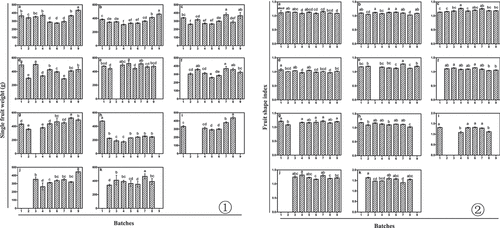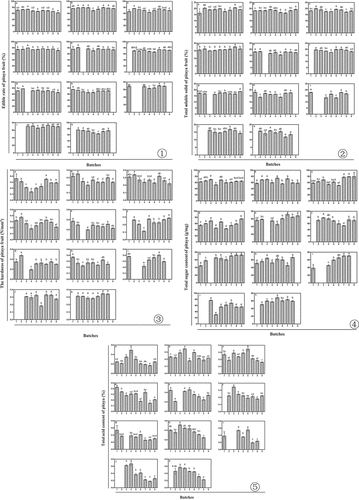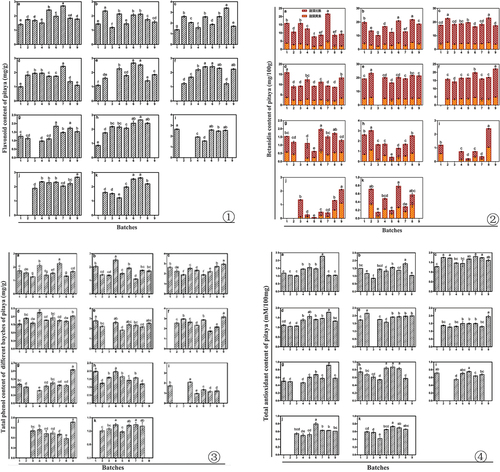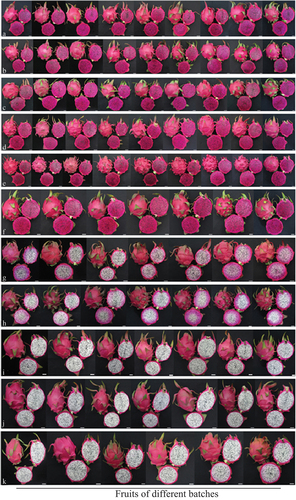ABSTRACT
Pitaya is a tropical and subtropical fruit; it can produce several batches fruit in one year. To find out the fruit quality differences between various batches in the same year in Guangzhou, South China, 11 pitaya varieties were used as the materials. Comparative analysis was performed between these varieties of each batch by 14 indexes, comprehensive evaluation and ranking were evaluated by the principal component analysis (PCA). Results showed that the red-peel and red-pulp pitaya has the longer fruit period and could obtain more batches fruits. By comparing the fruit quality of these 11 varieties in different batches: Except “Guanhuahong,” fruit weight is significant different between other 10 varieties. The edible rate of fruits from 2nd and 3rd batches is significantly higher than others. The hardness, total sugar, total acid, betalain, total phenol, and flavonoids were significant difference between batches. The PCA results indicated that in most varieties, the 1st, 8th, 9th batches are generally with heavier fruit, better color, harder and sweeter; more stable antioxidant compounds were shown in 6th, 7th, 8th, 9th batches; the 3rd, 4th, 5th, and 6th batches are smaller, softer, lower soluble sugar and higher titratable acid. Pitaya fruit quality and tastes from various batches are different in the same year, the climate may be the main factor. The fruits of 7th, 8th and 9th batches picking from Sep to Nov has better quality and higher economic value. This research has practical application value and could provide theoretical basis for the production of pitaya.
Introduction
Pitaya, also known as dragon fruit/pitahaya/strawberry pear, a plant growing in the tropics and subtropics, belongs to the genus Hylocereus of family Cactaceae, likely originated from tropical and subtropical areas of Latin America (Mexico and Colombia) (Chen et al., Citation2021). For its exotic appearance, delicate flavor, and unique aroma, it is now a globally commercial fruit crop (Zhang et al., Citation2021). Especially in South China, it developed quickly.
Fruit quality analysis helps to evaluate the fruit and directly determines its competitiveness in the market. An external aesthetic appearance and a sustainable internal quality of fruit are both crucial for consumers (Zhang et al., Citation2018), appearance quality mainly includes single fruit weight and fruit index, fruit color, etc., internal quality mainly includes hardness, sugar acid and other antioxidant substances, etc. And under the tropical and subtropical climate, pitaya can be harvested several times in one year; however, no studies have been reported about the fruit quality of different batches. Thus, it is necessary to study these various batches pitaya fruit quality. The aim of this research is to find out the fruit quality difference of several batches in the same variety during one year in Guangzhou China, we selected 11 pitaya varieties (including six red-peel and red-pulp varieties, three red-skin and white-pulp varieties, one red-peel and pink-pulp variety and one red-peel and bicolor-pulp variety). Fourteen indicators, including fruit weight, chromatic difference (L, a, b), fruit index, edible rate, TSS, hardness, betalain, total phenol, total flavonoids, total antioxidant activity, total acid and total sugar, were measured. The quality differences between the pitaya batches were compared by principal component analysis (PCA), and the climate effect on the pitaya fruit quality was discussed. We also analyzed the competitiveness of each batch of fruits in the market. The study results will provide a scientific reference for the pitaya production and improve the competitiveness of pitaya fruit in the fruit market.
Materials and Methods
Experimental Materials
Different batches of 11 varieties of pitaya () were selected, including six red-peel with red-pulp varieties (“Hongguan No.1”- nine batches, “Hongguan No.2”-nine batches, “Zhangjianghongrou”-nine batches, ’49–3’-nine batches, “Guanhuahong”-eight batches, “Hongshuijing”-eight batches), three red-skin with white-pulp varieties (“Guanhuabai”-six batches, “Hongbaoshi”-seven batches, “Yangxibairou”- seven batches), one red-peel and pink-pulp variety (“Guanhuahongfen”- eight batches) and one red-peel with bicolor-pulp variety (“Shuangse No.1”-eight batches). The fruits were picked with the same status in the sunny morning during 2018 from Jufeng Orchard in Baiyun District, Guangzhou, China. Each batch of every variety selected 15 consistent fruits at each time to measure the appearance quality, hardness and total soluble solids (TSS). Each batch of every variety also choose three other consistent fruit to cut small pieces in sealed bag and frozen at −80°C for the test of total antioxidant activity, betain, total phenol, flavonoids, total sugar, total acid, etc.
Measurement of Fruit Quality
Single fruit weight: it was measured by the 0.01 g balance. Edible rate (%): Edible rate (%) = (Single fruit weight-peel weight)/single fruit weight * 100%. Fruit color: By Chroma Meter CR-400 chromameter (Konica-Minolta, Japan). Fruit index: digital cursor caliper (0.01 mm) measured, fruit index = longitudinal diameter/horizontal diameter. TSS content: Determined by hand-held microreader. Hardness: Use FRUIT HARDNESS TESTER Cat No.9300 (KM-5) (Takemura, Japan) to test. Betalain: refer to Hua’s method (2018); Total phenol, antioxidant activity, flavonoid content, total sugar, total acid of pitaya fruit pulp: refer to Hua’s method (Citation2018). All the above treatments were measured in triplicate, five fruits for each treatment.
Principal Component Analysis (PCA)
Fourteen indexes for different batches of each variety were tested. PCA was carried by SPSS19.0. First standardize the raw data of 14 indicators of each variety, eliminate the influence of the scale, then conduct the PCA, according to the cumulative contribution rate and eigenvalue (>1), extract principal components, calculated from the component matrix (Z1, Z2 … Zn) and the eigenvalue to calculate the principal component coefficient matrix. Taking the ratio of the contribution rate of each principal component and the cumulative contribution rate as the weight, the comprehensive score of different batches of individual varieties is calculated and ranked according to the score.
Data Analysis
Microsoft Excel 2013 and SPSS 19.0 software were used to analyze the experimental data; significance difference analysis was compared with Duncan (p < .05); graph by GraphPad Prism 5.
Results
The Batches Number of Different Varieties in One Year
The results of this experiment showed that different pitaya varieties set different batches fruit in Guangzhou in the same year. The red-peel and red-pulp pitaya has the longer fruit period and could obtain more batches fruits than other varieties. This is consistent with the results of Xu’s (Citation2015), red-pulp pitaya varieties set two more batches’ fruits than white-pulp varieties in the same year in Zhejiang, which is located in North China.
Fruit Appearance Quality Analyse of Different Batches of Pitaya
Except “Guanhuahong” (-①-E), significant differences were found in the fruit weight of various batches from other ten varieties. Generally, in these 11 varieties, the fruits from batches of 1st, 8th, 9th were heavier than other batches, while batches of 4th,5th,6th were lighter than other batches. The fruit weight was found to be significantly different among batches; but no significant difference was found in the fruit shape index.
Figure 2. Fruit weight and fruit shape index of various batches pitaya. ①different batches of pitaya fruit weight; ②different batches of pitaya fruit shape index; a “hongguan No. 1;” B, “hongguan No. 2;” C, “Zhanjianghongrou;” D, “49–3;” E, “Guanhuahong;” F, “Hongshuijing;” G, “shuangse No. 1;” H, “Guanhuahongfen;” I, “Guanhuabai;” J, “Hongbaoshi;” K, “Yangxibairou”. (the vacancy in each picture means that variety could not setting fruits of that batches, related to variety characteristics or other special).

The color indexes of the 11 varieties are shown in , and the L* (brightness) was not significant difference among batches. The a* (red-green color) of fruit peel from batches of 2nd, 8th, 9th, were higher than other batches, means they has better color, while batches of 3rd, 4th, 5th,6th, were worse. The b* (yellow-blue color) were found higher in batches of 8th and 9th, and lower in batches of 4th, 5th, 6th. Taking consideration of these three values, it is found that the fruits from batches of 8th and 9th have a better appearance than other batches.
Figure 3. L, a, b value of different batches of pitaya peel. “Hongguan No. 1;” B, “hongguan No. 2;” C, “Z hanjianghongrou;” D, “49–3;” E, “Guanhuahong;” F, “Hongshuijing;” G, “shuangse No. 1;” H,“Guanhuahongfen;” I,“Guanhuabai;” J, “Hongbaoshi;” K, “Yangxibairou”. (the vacancy in each picture means that variety could not setting fruits of that batches, related to variety characteristics or other special circumstances).

Internal Quality Analyses of Various Batches of Pitaya
The internal quality of fruits from various batches of 11 varieties is shown in . The fruit edible rate from batches of 2nd and 3rd was found higher than other batches of these 11 varieties. The fruit TSS in batches of 2nd,3rd, 7th, 8th, was higher than other batches, while 4th and 6th was lower. Significant difference was found in the fruit hardness of various batches in nine varieties (except “Hongbaoshi” and “Yangxibairou”), fruits of 3rd and 4th batch were softer than other batches. Total sugar and total acid in the fruits were showed significant difference of various batches, it is found higher total sugar in the batches of 2nd, 3rd, 5th, 7th, 8th and 9th, and higher total acid in batches of 1st, 3rd, 4th, 5th 6th. Significant difference was found in betain of various batches in 11 varieties, eight varieties were found higher in the 8th batch while in the batches of 3rd, 4th and 5th were lower.
Figure 4. Fruit quality of different batches of pitaya fruit. ① Edible rates of different batches of pitaya; ② TSS of different batches of pitaya; ③ Pulp hardness of different batches of pitaya; ④ Total sugar content of different batches of pitaya; ⑤ Total acid content of different batches of pitaya A, “hongguan No. 1;” B, “hongguan No. 2;” C, “Zhanjianghongrou;” D, “49–3;” E, “Guanhuahong;” F, “Hongshuijing;” G, “Shuangse No 1;” H, “Guanhuahongfen;” I, “Guanhuabai;” J, “Hongbaoshi;” K, “Yangxibairou.” (the vacancy in each picture means that variety could not setting fruits of that batches.

The internal properties of fruit from various batches of 11 varieties are shown in . Higher flavonoids were found in the 7th batch while lower in the 1st batch of ten varieties (except “Hongbaoshi”). The total phenol content of the 11 varieties varied significantly between batches, relatively lower but stable in the batches of 3rd, 5th, 6th, 7th and 8th, while the 4th and 9th batches are higher. As phenolic substances, flavonoids and total phenol content distribution show different rules in this study and should be further studied. It is found that the total antioxidant activity of 11 varieties is stable and relatively higher in batches of 5th,6th, 7th, 8th, 9th, while lower in the batches of 2nd,3rd and 4th.
Figure 5. Nutrition composition of different batches of pitaya fruit pulp. ①Betanidin content of different batches of pitaya;②Flavonoids content of different batches of pitaya;③Total phenol content of different batches of pitaya;④Total antioxidant content of different batches of pitaya. A, “hongguan No. 1;” B, “hongguan No. 2;” C, “Zhanjianghongrou;” D, “49–3;” E, “Guanghuahong;” F, “Hongshuijing;” G, “Shuangse No 1;” H, “Guanhuahongfen;” I, “Guanhuabai;” J, “Hongbaoshi;” K, “Yangxibairou”. (the vacancy in each picture means that variety could not setting fruits of that batches, related to variety characteristics or other special circumstances). related to variety characteristics or other special circumstances).

Principal Component Analysis and Comprehensive Evaluation of Various Batches of Pitaya Fruit
In order to evaluate fruit quality of these 11 varieties from various batches, 14 indicators were combined into several relatively independent new indicators to extract the principal components. When the characteristic value is more than 1, this means that the components can show the information of the variety of fruit quality. The extract principal components and the calculation formula are shown in .
Table 1. The principal components for different varieties of pitaya.
Discussion and Conclusion
Effect of Climate Factors on Pitaya Quality
The fruits in this study are harvested from June to November 2018, totally nine batches. In South China, take Guangzhou as example, the temperature is high with a lot of rain from July to September. Our results showed that climate is the main factor to affect the fruit quality.
Single fruit weight: the fruits of the 1st,8th,9th batches are heavier while the 4th,5th, and 6th batches are lighter. Significant difference can be found between batches. The fruit of 1st batch were harvested in June, the 8th and 9th batches were harvested in October and November, in South China, these three months are colder than August and September, and with bigger temperature difference between day and night. The longer fruit development period, more accumulation of photosynthesis and less respiratory consumption which cause the bigger fruit. Pollination is undoubtedly controlled by weather conditions such as rain (Eisikowitch et al., Citation1991). July and August are the rainy seasons in Guangzhou, so the fruit is smaller than other seasons. The rainy-day effect of the fruit quality is also found in loquat (Freihat et al., Citation2008).
Color: Combined L, a and b values, it is found that, compared with other batches, the peel color of 8th and 9th are significant different. These two batches of fruit harvested in October–November, the end of the rainy season in Guangzhou, the temperature become lower. This is consistent with Yang’s conclusion that during apple fruit coloring, the low temperature, the fine weather and the less precipitation are beneficial for the fruit coloring (Yang et al., Citation2010).
Fruit hardness: the fruits from 3rd, 4th, 5th, 6th batches are softer, while the 1st, 2nd, 7th, 8th batches are harder for the 11 pitaya varieties. Fruit hardness is related to sunlight and temperature. During the low daily temperature and low average minimum temperature (late June to early July), fruit grows slow, and cause the dense flesh, the cell-cell gap is smaller, and vice versa. During periods of abundant light with large temperature difference between day and night (late August to mid-September), the fruit was also significantly harder.
Total sugar and total acid: The soluble sugar of fruits in 7th,8th, and 9th is relatively higher than other batches, while the titrating acid content is low. These batches are harvested from October to November with large temperature difference between day and night, which is good for the photosynthesis accumulation; and less rain is better for the fruit development. In the contrast, the 4th, 5th and 6th batches are harvested in August and September, which is rainy season in Guangzhou, growing season meets heavy rain would cause the worse fruit quality, especially in the key period of fruit formation, too much rain will reduce the sugar-acid content in the fruit, and the small temperature difference between day and night cause the lower net photosynthesis accumulation.
Betalain, flavonoids and other phenols are related to the color formation of the peel, but also related to the antioxidant activity of the fruit. This experiment cannot see the direct impact of climate factors, and the complex relationship between them needs the further investigation.
Similar as other places in South China, it is hot and too much rain in the summer of Guangdong, especially in July and August, if too much rain during flowering and pollination, it will cause the pollination failure, susceptible to disease, moreover, it will worsen the fruit quality. This study is consistent with previous research on apple that growth period with high temperature and rain will cause the slightly poor quality (Qu and Zhou, Citation2016).
PCA and Comprehensive Evaluation
The PCA reduces each index to several relatively independent and small composite indicators by retaining most of the information. This method can comprehensively analyze and evaluate multiple quality indicators, with less influence of subjective factors. PCA can not only objectively select the resources with excellent comprehensive quality but also make an appropriate evaluation of the various resources according to the scores. It can avoid the elimination of some good quality resources but also can comprehensive evaluation and ranking of each resource.
In order to evaluate the fruit quality of the 11 varieties more objectively, the 14 different quality indicators were combined into several relatively independent new indicators. By the PCA, the principal components of each variety were extracted according to the cumulative contribution rate and eigenvalues, and then various batches of each variety were ranked by the scores.
Evaluation of the market efficiency of pitaya fruit in different seasons
Through the previous quality analysis and PCA of the fruits from various batches of 11 varieties, the results showed the fruits of the 7th, 8th, and 9th batches are bigger with better appearance and harder; fruits from 6th, 7th, 8th, and 9th batches with more stable antioxidant, better comprehensive quality; fruits from 3rd, 4th, 5th, 6th batches generally set smaller fruit with soft pulp and high titrate acid, which are relatively poor comprehensive quality.
The harvest time affects the price of pitaya, the 3rd, 4th, 5th and 6th batches are harvested from July to September, and the 7th, 8th and 9th batches are harvested in October and November. According to the world tropical agriculture information (2018), the average wholesale price of pitaya in June 2018 was 1.2 Dollar/kg in July the average wholesale price was 1.22 Dollar/kg, in August the average wholesale price was 1.36 Dollar/kg. From June to August, this period is the harvest time of pitaya, as well as watermelon, peaches, cantaloupe and other fruits, the market competition caused the low price of pitaya in China. In September, the national average wholesale price of pitaya was 1.43 Dollar/kg. With the National Day approaching and the high fruit price on the Mid-Autumn Festival, the market demand for pitaya was inevitably increased. In October, the average price of pitaya in October was 1.50 Dollar/kg. After November, although pitaya is getting less and less, apples, citrus and other fruits are harvested, which can replace consumers’ demand for fresh pitaya fruit. The price of pitaya is better in September to November than June to August. In August, the price of mature fresh fruit of the same grade is the lowest.
In this case, we need to regulate the fruit harvest time, and the fruit harvest time in August can be appropriately adjusted to the early-mid September. It can meet the demand and price peak before the Mid-Autumn Festival. From September to November, fruits are from the 6th, 7th, 8th and 9th batches. Taking account, the combination of fruit quality and comprehensive evaluation, the fruits of 7th, 8th and 9th batches have better quality and higher price.
The cultivation and management technology of pitaya in the fruit is relatively mature and stable. It included regular fertilization, irrigation and pest control every month, but the monthly cost is slightly different. In October and November, the less rain causes the need of irrigation, and the short light of autumn and winter means the need of artificial light. The fruit development is slow, which need more than 40 days to harvest, but the fruit is big with high quality. July to September is the rainy season in Guangzhou, the weather is hot with lots of rain, pest-like flies is causing the fruit decay and relatively poor fruit quality.
There are significant differences in the quality of various batches of pitaya fruit in one year, which can be regulated by the cultivation technology to meet the market demand and improve the fruit quality. At the same time, the cultivation measures can be taken in the rainy season or the key periods of flowers and fruits developments. This study has practical application value and can provide a theoretical basis for the production of pitaya fruit.
Acknowledgments
This study was supported by the Key Science and Technology Planning Project, Guangzhou city, Project No. 201904020015; Science and Technology Program, Guangzhou, Project No. 202002020060; and Science and Technology Program, Zhanjiang, Project No. 2019A01003.
Disclosure statement
No potential conflict of interest was reported by the author(s).
Additional information
Funding
References
- Chen, J.Y., F.F. Xie, Y.Z. Cui, C.B. Chen, W.J. Lu, X.D. Hu, Q.Z. Hua, J. Zhao, Z.J. Wu, D. Gao, et al. 2021. A chromosome-scale genome sequence of pitaya (Hylocereus undatus) provides novel insights into the genome evolution and regulation of betalain biosynthesis. Hortic Res 8(1):164. doi: 10.1038/s41438-021-00612-0.
- Eisikowitch, D., Z. Gat, O. Karni, F. Chechik, and D. Raz. 1991. Almond blooming under adverse conditions. A compromise between various forces proceeding of plant—animal interaction in Mediterranean type eco-systems. Crete Greece Medecos, VI, pp. 234–240.
- Freihat, N.M., A.M. Al-Ghzawi, S. Zaitoun, and A. Alqudah. 2008. Fruit set and quality of loquats (Eriobotrya japonica) as effected by pollinations under sub-humid mediterranean. Sentia Horticulturae 117(1):58–62. doi: 10.1016/j.scienta.2008.03.012.
- Hua, Q.Z., C.B. Chen, N.T. Zur, H.C. Wang, J.Y. Wu, J.Y. Chen, Z.K. Zhang, J.T. Zhao, G.B. Hu, and Y.H. Qin. 2018. Metabolomic characterization of pitaya fruit from three red-skinned cultivars with different pulp colors. Plant Physiol. Bioch. 126:117–125. doi: 10.1016/j.plaphy.2018.02.027.
- Qu, Z., and G. Zhou. 2016. Possible impact of climate change on the quality of apples from the major producing areas of China. Atmosphere 7(9):113. doi: 10.3390/atmos7090113.
- Xu, X.J. 2015. “Introduction performance of several pitaya varieties in Wenling, Zhejiang province.” South China Fruits 44 (4):67–69. In Chinese.
- Yang, S.Y., Y.E. Tang, and G.J. Xiao. 2010. “The influence of climate change on apple growth in weibei dry highland for last 48 years.” Chinese Agricultural Science Bulletin 26 (12):365–370. In Chinese.
- Zhang, B., D. Dai, J. Huang, J. Zhou, Q. Gui, and F. Dai. 2018. Influence of physical and biological variability and solution methods in fruit and vegetable quality nondestructive inspection by using imaging and near-infrared spectroscopy techniques: A review Crit. Rev. Food Sci. Nutr 58(12):2099–2118. doi: 10.1080/10408398.2017.1300789.
- Zhang, Z.K., Y.M. Xing, M. Ramakrishnan, C.B. Chen, F.F. Xie, Q.Z. Hua, J.Y. Chen, R. Zhang, J.T. Zhao, G.B. Hu, et al. 2021. Transcriptomics-based identification and characterization of genes related to sugar metabolism in ‘hongshuijing’ pitaya. Horticultural Plant Journal 8(4):450–460. doi: 10.1016/j.hpj.2021.06.004.

